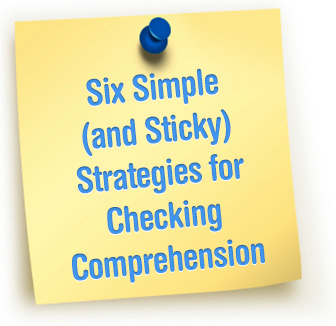7 Easy Icebreakers You Can Do With Post-It Notes


Here are some fun and easy ways to check how much they know and remind them of what they don’t that take nothing more than a pack of post-it notes!

The next time you are looking for a fun way to review before a test, try making a Jeopardy board out of post-it notes. On the sticky side, write the “answer”, and write the point value on the other side. Then arrange the post-its into categories: grammar, vocabulary, content, etc. To play, the student whose birthday is closest to today chooses the first category and point value. You remove the post-it and read the answer to the class. Call on the first person to raise his hand for the “question”, and only accept answers that are phrased as questions. Award points to individuals or teams of students. Not only is this activity good for reviewing information before a test, it gives your students additional practice in forming questions.
Another way to review information before a test uses post-its and tongue depressors. Write several review questions on a corresponding number of tongue depressors. Make sure you have at least one question for each person in your class. You may want to think about categories of questions as you write them: vocabulary, grammar, etc. Vary the categories depending on what information you are reviewing. Then choose one color post-it to represent each category, and affix a note of that color to the bottom of each tongue depressor. Put all the questions in a can with the post-its up, and let each person choose one review question. If the students answers her question correctly, she should write her name on the post-it and stick it in a designated area in the front of the room. After a month, a marking period or some other designated amount of time, the person with the most post-its on the board is the class champion.
It is inevitable that in your ESL class, some students will be talkers and others will be silent during class. This can make it difficult to know just how much each student understands, especially during listening comprehension lectures. To check in real time exactly what your students are getting, give each student a post-it note, and ask a comprehension question. Have your students write their one word answer on the post-it and stick it to their foreheads. This silly way of checking on what each student knows will subvert some students’ tendencies to be quiet during class. Plus, since your students are facing you, no one will be intimidated by his classmates looking at his answer.
This exercise is particularly useful when you are reviewing a piece of literature your students have read. Ask your students to think about the important events in the narrative they read. Each student then writes 10 events from story on individual post-its and copies those events in chronological order on a separate sheet of paper (the answer key). Hand out small zip lock bags to your class and have them first mix up the order of the notes and then place them into the bag with the folded answer key. Pairs of students can then exchange bags and place their classmate’s events in the correct sequence; they can check them against the answer key when finished.
To close out your day and get a litmus test on what your students remember most from the day, require each student to give you a ticket before he or she leaves for the day. To create the ticket, simply give each person a post-it note and require that he writes one thing that he learned during the day’s lessons. As he walks out the door, the student hands you his ticket. He remembers more of what you covered in class, and you get a read on what your students enjoyed and remembered from today’s material.
You can add excitement and a little bit of chance to your next test review by playing this simple game that requires nothing more than a pack of post-it notes. Prepare for the game by writing each of your review questions on the sticky side of a post-it note. You will also need several post-its with no question written on them. Place the question sticky notes and the blank ones in a grid pattern on your front board. You should vary the size of the grid based on the number of questions you have for your students. For example, if you have 20 review questions, create a 6x6 grid. Scatter the questions among the grid and fill in any empty spaces with the blank post-its. Each student takes a turn choosing one of the sticky notes. If that note has a question written on it, the student must answer the question correctly in order to keep the sticky note. If there is no question on the sticky note, the student keeps it. An unanswered question goes back in its place on the board and waits until another student chooses it. Once all the post-its are taken, count up the notes. The student with the most notes wins the game.
Plus, you won’t get stuck in a review rut.